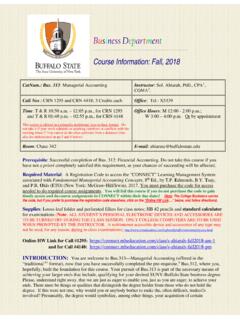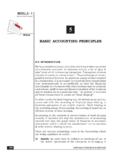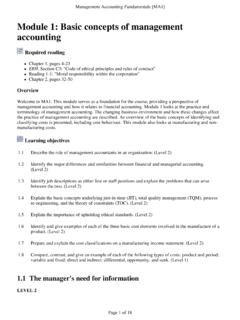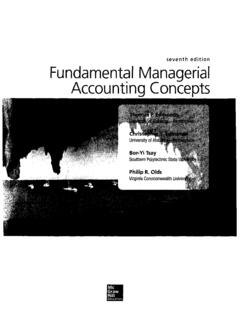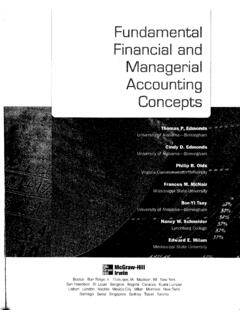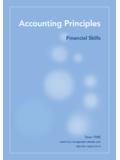Transcription of chap002 Managerial Accounting and Cost Conepts
1 The McGraw-Hill Companies, Inc., 2012. All rights reserved. Solutions Manual, Chapter 2 19 Chapter 2 Managerial Accounting and Cost Concepts Solutions to Questions 2-1 Managers carry out three major activities in an organization: planning, directing and motivating, and controlling. Planning involves establishing a basic strategy, selecting a course of action, and specifying how the action will be implemented. Directing and motivating involves mobilizing people to carry out plans and run routine operations. Controlling involves ensuring that the plan is actually carried out and is appropriately modified as circumstances change. 2-2 The planning and control cycle involves formulating plans, implementing plans, measuring performance, and evaluating differences between planned and actual performance. 2-3 In contrast to financial Accounting , Managerial Accounting : (1) focuses on the needs of managers rather than outsiders; (2) emphasizes decisions affecting the future rather than the financial consequences of past actions; (3) emphasizes relevance rather than objectivity and verifiability; (4) emphasizes timeliness rather than precision; (5) emphasizes the segments of an organization rather than summary data concerning the entire organization; (6) is not governed by GAAP; and (7) is not mandatory.
2 2-4 The three major elements of product costs in a manufacturing company are direct materials, direct labor, and manufacturing overhead. 2-5 a. Direct materials are an integral part of a finished product and their costs can be conveniently traced to it. b. Indirect materials are generally small items of material such as glue and nails. They may be an integral part of a finished product but their costs can be traced to the product only at great cost or inconvenience. c. Direct labor consists of labor costs that can be easily traced to particular products. Direct labor is also called touch labor. d. Indirect labor consists of the labor costs of janitors, supervisors, materials handlers, and other factory workers that cannot be conveniently traced to particular products. These labor costs are incurred to support production, but the workers involved do not directly work on the product. e. Manufacturing overhead includes all manufacturing costs except direct materials and direct labor.
3 Consequently, manufacturing overhead includes indirect materials and indirect labor as well as other manufacturing costs. 2-6 A product cost is any cost involved in purchasing or manufacturing goods. In the case of manufactured goods, these costs consist of direct materials, direct labor, and manufacturing overhead. A period cost is a cost that is taken directly to the income statement as an expense in the period in which it is incurred. 2-7 The income statement of a manufacturing company differs from the income statement of a merchandising company in the cost of goods sold section. A merchandising company sells finished goods that it has purchased from a supplier. These goods are listed as purchases in the cost of goods sold section. Because a manufacturing company produces its goods rather than buying them from a supplier, it lists cost of goods manufactured in place of purchases. Also, the manufacturing company identifies its inventory The McGraw-Hill Companies, Inc.
4 , 2012. All rights reserved. 20 Managerial Accounting , An Asian Perspective in this section as Finished Goods inventory, rather than as Merchandise Inventory. 2-8 The schedule of cost of goods manufactured lists the manufacturing costs that have been incurred during the period. These costs are organized under the three categories of direct materials, direct labor, and manufacturing overhead. The total costs incurred are adjusted for any change in the Work in Process inventory to determine the cost of goods manufactured ( finished) during the period. The schedule of cost of goods manufactured ties into the income statement through the cost of goods sold section. The cost of goods manufactured is added to the beginning Finished Goods inventory to determine the goods available for sale. In effect, the cost of goods manufactured takes the place of the Purchases account in a merchandising firm. 2-9 A manufacturing company usually has three inventory accounts: Raw Materials, Work in Process, and Finished Goods.
5 A merchandising company may have a single inventory account Merchandise Inventory. 2-10 Product costs are assigned to units as they are processed and hence are included in inventories. The flow is from direct materials, direct labor, and manufacturing overhead to Work in Process inventory. As goods are completed, their cost is removed from Work in Process inventory and transferred to Finished Goods inventory. As goods are sold, their cost is removed from Finished Goods inventory and transferred to Cost of Goods Sold. Cost of Goods Sold is an expense on the income statement. 2-11 Yes, costs such as salaries and depreciation can end up as part of assets on the balance sheet if they are manufacturing costs. Manufacturing costs are inventoried until the associated finished goods are sold. Thus, if some units are still in inventory, such costs may be part of either Work in Process inventory or Finished Goods inventory at the end of the period.
6 2-12 No. A variable cost is a cost that varies, in total, in direct proportion to changes in the level of activity. The variable cost per unit is constant. A fixed cost is fixed in total, but the average cost per unit changes with the level of activity. 2-13 A differential cost is a cost that differs between alternatives in a decision. An opportunity cost is the potential benefit that is given up when one alternative is selected over another. A sunk cost is a cost that has already been incurred and cannot be altered by any decision taken now or in the future. 2-14 No, differential costs can be either variable or fixed. For example, the alternatives might consist of purchasing one machine rather than another to make a product. The difference between the fixed costs of purchasing the two machines is a differential cost. The McGraw-Hill Companies, Inc., 2012. All rights reserved. Solutions Manual, Chapter 2 21 Exercise 2-1 (10 minutes) 1.
7 Directing and motivating 2. Budgets 3. Planning 4. Precision; Timeliness 5. Managerial Accounting ; Financial Accounting 6. Managerial Accounting 7 Financial Accounting ; Managerial Accounting 8. Feedback 9. Controller 10. Performance report The McGraw-Hill Companies, Inc., 2012. All rights reserved. 22 Managerial Accounting , An Asian Perspective Exercise 2-2 (10 minutes) 1. The cost of a hard drive installed in a computer: direct materials. 2. The cost of advertising in the Puget Sound Computer User newspaper: selling. 3. The wages of employees who assemble computers from components: direct labor. 4. Sales commissions paid to the company s salespeople: selling. 5. The wages of the assembly shop s supervisor: manufacturing overhead. 6. The wages of the company s accountant: administrative. 7. Depreciation on equipment used to test assembled computers before release to customers: manufacturing overhead.
8 8. Rent on the facility in the industrial park: a combination of manufacturing overhead, selling, and administrative. The rent would most likely be prorated on the basis of the amount of space occupied by manufacturing, selling, and administrative operations. The McGraw-Hill Companies, Inc., 2012. All rights reserved. Solutions Manual, Chapter 2 23 Exercise 2-3 (15 minutes) Product Cost Period Cost 1. Depreciation on salespersons cars .. X 2. Rent on equipment used in the factory .. X 3. Lubricants used for machine X 4. Salaries of personnel who work in the finished goods warehouse .. X 5. Soap and paper towels used by factory workers at the end of a X 6. Factory supervisors X 7. Heat, water, and power consumed in the X 8. Materials used for boxing products for shipment overseas (units are not normally boxed).. X 9. Advertising X 10.
9 Workers compensation insurance for factory employees .. X 11. Depreciation on chairs and tables in the factory lunchroom .. X 12. The wages of the receptionist in the administrative offices .. X 13. Cost of leasing the corporate jet used by the company's executives .. X 14. The cost of renting rooms at a Florida resort for the annual sales conference .. X 15. The cost of packaging the company s product .. X The McGraw-Hill Companies, Inc., 2012. All rights reserved. 24 Managerial Accounting , An Asian Perspective Exercise 2-4 (15 minutes) CyberGames Income Statement Sales .. $1,450,000 Cost of goods sold: Beginning merchandise inventory .. $ 240,000 Add: 950,000 Goods available for 1,190,000 Deduct: Ending merchandise inventory .. 170,000 1,020,000 Gross margin.
10 430,000 Selling and administrative expenses: Selling 210,000 Administrative 180,000 390,000 Net operating income .. $ 40,000 The McGraw-Hill Companies, Inc., 2012. All rights reserved. Solutions Manual, Chapter 2 25 Exercise 2-5 (15 minutes) Lompac Products Schedule of Cost of Goods Manufactured Direct materials: Beginning raw materials $ 60,000 Add: Purchases of raw materials .. 690,000 Raw materials available for use .. 750,000 Deduct: Ending raw materials 45,000 Raw materials used in $ 705,000 Direct 135,000 Manufacturing overhead .. 370,000 Total manufacturing costs .. 1,210,000 Add: Beginning work in process inventory .. 120,000 1,330,000 Deduct: Ending work in process inventory.
